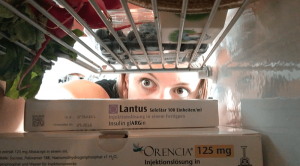People with diabetes usually store their lifesaving insulin in the refrigerator at home, based on recommendations made by many insulin manufacturers. But a new study shows that the refrigerator may not be the ideal place to ensure that insulin is stored at a stable and consistent temperature.
The new report by the European Association for the Study of Diabetes (EASD) pointed out some of the potential dangers from storing insulin in the refrigerator. Researchers provided diabetes patients living in the United States and Europe with refrigerator thermometers to see if their home refrigerators stayed within the recommended range for insulin storage, which is between 2°C (36°F) and 7°C (43°F).
They also looked at variances in insulin temperature among those who did not store their insulin in the fridge, putting temperature sensors in their diabetes bags. The results were quite surprising. Almost 80 percent of study participants saw their insulin fall out of the recommended range some of the time during the trial. In addition, insulin stored in the refrigerator fell out of the recommended temperature range for the equivalent of 2 hours and 34 minutes daily, or 11 percent of the total observed storage time.
By contrast, people who stored insulin outside of the fridge, only saw the medication fall out of the ‘safe’ range for roughly 8 minutes daily. Attributing the results of the study to different types of insulin, a spokesperson for the US Food and Drug Administration (FDA) said: “Insulin products contained in vials or cartridges supplied by the manufacturers (opened or unopened) may be left unrefrigerated, at a temperature between 15°C (59°F) and 30°C (86°F), for up to 28 days and continue to work.” Though it might appear to be counterintuitive, since the refrigerator is a more tightly controlled temperature environment, apparently, non-refrigerated insulin has a wider recommended range before it becomes unusable.
However, this makes sense, when you look at conflicting recommendations. For example, the FDA recommends that refrigerators be set at 40°F or below for food safety. In addition, refrigeratormakers often state that a slight temperature fluctuation of plus or minus 5° is typical for a refrigerator. Add to this the temperature fluctuations that can come from opening and closing your refrigerator too often.
For instance, say you set your fridge at 3°C (37°F) just to be on the safe side for food safety, and you are storing your insulin in there. Per the manufacturer, your refrigerator’s internal temperature could dip as low as 0°C (32°F), which is several degrees lower than what insulin manufacturers recommend. That poses a risk. Insulin should be kept as cool as possible, but should not be frozen.
Frozen insulin should not be used. People, however, do not want to throw their insulin away, especially as the price of insulin has skyrocketed in recent years. That puts more pressure on patients who need the hormone to make sure it is stored safely and none of it is wasted.
There are some solutions in the works, including insulin that never needs refrigeration and can sustain temperatures up to 55°C (130°F). In the meantime, people who use liquid insulin that needs to be refrigerated, should keep a closer eye on their refrigerator temperature, as long-term storage conditions of insulin are known to have an impact on its blood-glucose lowering effect. Moreover, not everywhere in the refrigerator is created equal. Be aware of the cold and warm zones in the refrigerator.
Earlier people used the butter compartment to store it, but if that is on the door it might not be the best place. Instead, store your insulin on the center shelf or consider getting a small, dedicated refrigerator for your insulin that will not be subject to temperature fluctuations of your main unit. While more research is needed to examine the extent to which temperature deviations during domestic storage affect insulin efficacy and patient outcomes, an insulin product that has been altered for the purpose of dilution, or by removal from the manufacturer’s original vial, should be discarded within two weeks.






















